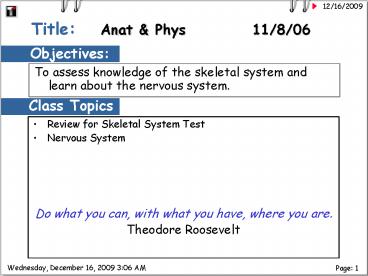Review for Skeletal System Test PowerPoint PPT Presentation
Title: Review for Skeletal System Test
1
Class Topics
Title Anat Phys 11/8/06
Objectives
- To assess knowledge of the skeletal system and
learn about the nervous system.
- Review for Skeletal System Test
- Nervous System
- Do what you can, with what you have, where you
are. - Theodore Roosevelt
Wednesday, December 16, 2009 306 AM
2
Class Assignments
By When
What
- Skeletal System Test 11/8/06
- Read 240-270
- Due this class period
- Due next class period
- Due in the future
3
Posttest Activities
- Read 240-270
4
(No Transcript)
5
Neuroglia (Figure 9-2)
- Astrocytes - CNS - control blood flow
- ependymal cells - CNS - form CSF
- Microglia - CNS - used to clean
- Oligodendrocytes - CNS - used to speed up action
potentials - Schwann cells - found in PNS - aids in conduction
of action potential and helps large neurons
6
Neuron Parts
- Cell body
- cytoplasm, nucleus (with nucleolus), and
organelles - organelles including Nissl bodies (like RER) and
lacking mitotic spindles - Dendrites
- numerous
- conduct action potential towards cell body
- Axon
- single
- conduct action potential away from cell body
7
(No Transcript)
8
Resting Membrane Potential
- Difference in charge on inside and outside of
plasma membrane - unequal distribution of ions
- Ion channels
- integral proteins that regulate ion movement in
cell membrane - not only in nerve cells
9
Resting Membrane Potential (cont.)
- Ions most often found
- Na, K
- More sodium outside and potassium inside
- this imbalance is kept by the sodium- potassium
pump - uses energy to move the ions out/in the cell
10
Sodium-Potassium Pump
- Forces Na out and K in the cell
- Creates a concentration gradient
- Na diffuses in and K diffuses out
- Pump doesnt work evenly
- 3 Na for every 2 K
- Creates an electrical gradient with more positive
charges on the outside - K diffuses more readily than Na
- Increases the electrical gradient
11
- Inside the cell
- Negatively charged
- Lack of positive ions and presence of Cl- ions
- Cell is at resting potential
- Ready to go at stimulus
- POLARIZED
- Voltage
- About 70 mV (millivolts)
- Very small amount
- A D battery has about 1.5 volts
PowerShow.com is a leading presentation sharing website. It has millions of presentations already uploaded and available with 1,000s more being uploaded by its users every day. Whatever your area of interest, here you’ll be able to find and view presentations you’ll love and possibly download. And, best of all, it is completely free and easy to use.
You might even have a presentation you’d like to share with others. If so, just upload it to PowerShow.com. We’ll convert it to an HTML5 slideshow that includes all the media types you’ve already added: audio, video, music, pictures, animations and transition effects. Then you can share it with your target audience as well as PowerShow.com’s millions of monthly visitors. And, again, it’s all free.
About the Developers
PowerShow.com is brought to you by CrystalGraphics, the award-winning developer and market-leading publisher of rich-media enhancement products for presentations. Our product offerings include millions of PowerPoint templates, diagrams, animated 3D characters and more.

